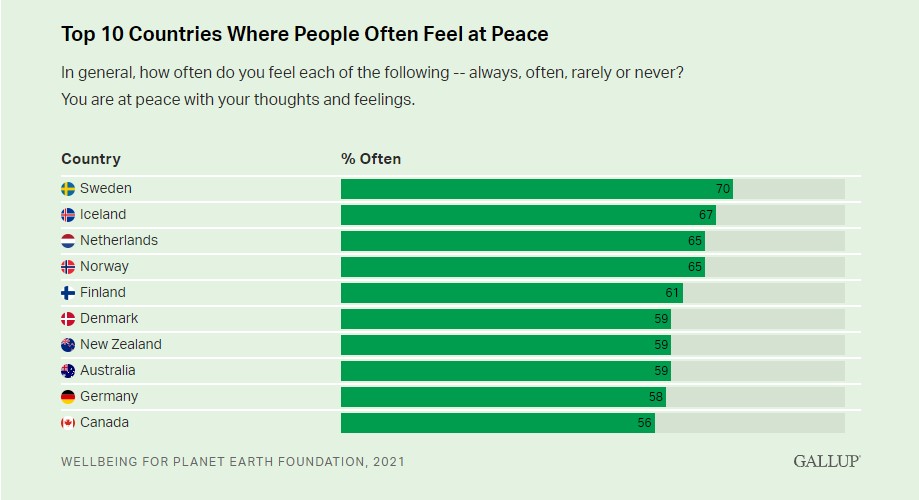Who Feels Personal Peace on Earth? (Gallup)
By Kristjan Archer
At this time of year, along with their best hopes for the coming year, many people around the world are wishing others peace. But how often do people worldwide feel at peace?
In 2021, as part of the Wellbeing for Planet Earth Foundation and Gallup initiative to develop a more holistic understanding of wellbeing, Gallup asked adults in 122 countries how often they feel at peace with their thoughts and feelings.
As might be expected, the study found people’s answers varied around the world — but on average, people were more likely to feel at peace always (34%) or often (39%) rather than rarely (17%) or never (5%).
Key Findings
Latin American Countries Dominate the ‘Always at Peace’ List
Worldwide, the percentage of people who say they “always” feel at peace with their thoughts and feelings — the highest bar for these experiences — ranges from a low of 11% in Zimbabwe to a high of 73% in Nicaragua.
The list of countries worldwide where the majority of people say they always feel this way is dominated by countries in Latin America and the Caribbean. Only five out of the 14 countries where majorities always feel at peace are not in this region.

The plethora of Latin American countries that top this list may not be entirely surprising: Many of these same countries regularly rank among the most likely in the world to report experiencing positive emotions each day, such as feeling well-rested, smiling or laughing, learning something interesting, feeling treated with respect, and experiencing enjoyment.
Compared with their counterparts in Latin America, people in countries in Northern America — including the U.S. (28%) and Canada (26%) — are significantly less likely to say they always feel at peace with their thoughts and feelings.
Nordic Countries Are Often at Peace, but Not Always
“Often” feeling at peace with one’s thoughts and feelings is more common around the world than “always” feeling this way. In 27 countries, the majority of people say they feel at peace with their thoughts and feelings this regularly.
Nordic countries and other high-income economies that usually top the list of the world’s “happiest” countries based on their life evaluations also top the list of countries where the largest shares of the population are often at peace. This suggests that it is important to look at wellbeing in more ways than life evaluations alone, as it may not describe the full picture of a person’s existence.

Peace More Elusive in Several Parts of the Globe
While much of the world feels at peace with their thoughts and feelings, this experience eludes many in countries that span Africa, Asia, Europe, and the Middle East and North Africa.
In Zimbabwe, for example, nearly seven in 10 residents (69%) rarely or never feel at peace with their thoughts and feelings — including a majority (54%) who rarely feel this way. Majorities in Turkiye (63%) and Malawi (59%) also rarely or never feel this way.

Implications
Peace can mean many things, whether it is calmness and tranquility within oneself or literally the absence of war. Definitions of peace typically fall into two main categories: outer or external peace and inner peace. The former is a collective phenomenon, occurring at either a group or societal level, referring to the relationship among people. The latter is individualistic, centered on a single person, referring broadly to their state of mind.
In recent years, inner peace has been attracting greater research interest, as reflected in the Global Wellbeing Initiative survey. Even so, given that scholarship on inner peace is only just starting to develop, there are many research questions and issues that need to be explored. For example, much still needs to be studied on the relationship between inner and outer peace — how does one affect the other?
Can someone have consistent inner peace when surrounded by strife? Gallup and the Global Wellbeing Initiative plan to continue to explore people’s relationship to peace as part of their efforts to create a more holistic understanding of wellbeing. The research partnership will culminate in a detailed report of the findings in fall 2023.
Tagged
Related Insights
Discover what our researchers and industry experts are saying about wellbeing.
See More Insights